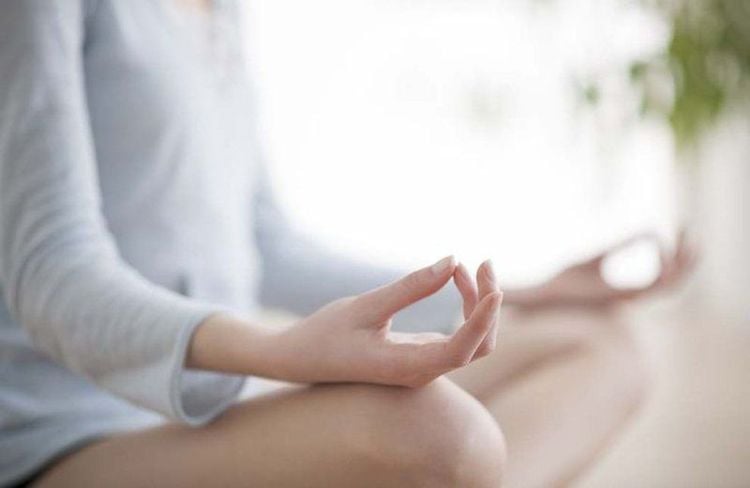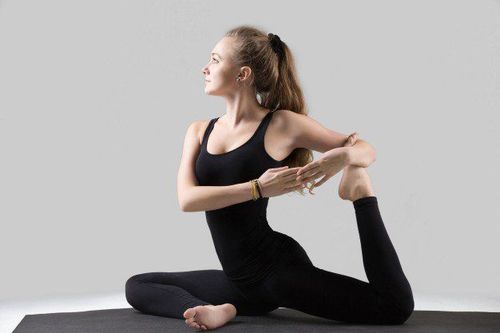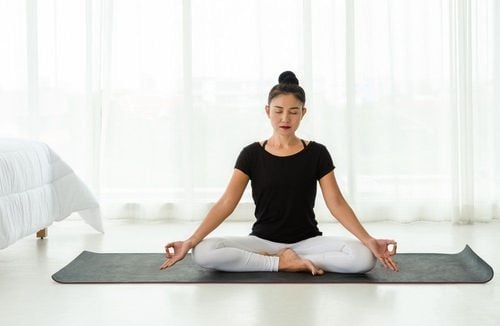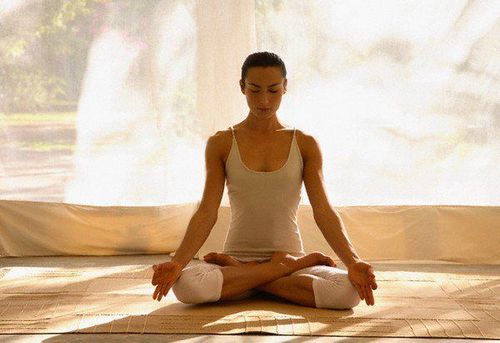This is an automatically translated article.
Falling asleep while meditating is very normal and if it happens to you every now and then you don't need to worry too much. When we learn to meditate, we are looking for a balance between focus and relaxation, and in that learning process it is inevitable that sometimes we will go too far in either direction, sometimes feel too stressed and other times fall asleep. Learning to apply the right amount of effort is a very delicate thing and requires practice.1. Does meditation make you feel sleepy?
Meditation does not make you tired. Meditation is said to improve memory, prevent depression, reduce feelings of stress, make us smarter, and even make us rich. According to neurobiologists, meditation can cause some positive physical changes to our brain structure over many years. But if meditation is so beneficial, then why is it that some people (like me) have a hard time staying awake whenever they try2. Some Ways to Stay Sober
Falling asleep while meditating is very normal and if it happens to you every now and then you don't need to worry too much. When we learn to meditate, we are looking for a balance between focus and relaxation, and in the process it is inevitable that sometimes we will go too far in either direction. when feeling too stressed and other times falling asleep. Learning to apply the right amount of effort is a very delicate thing and requires practice. And of course, every day is different, so this learning process continues. However, there are some things we can do to reduce the chances of it happening.Here are some practical tips to stay awake:
Meditate while sitting up rather than lying down. It sounds obvious, but lying down encourages a more sleepy mental state. Avoid meditating in bed, in bed, or around the bed. For most people, the bed only makes sense, so find a more sober environment if you can. Try meditating first thing in the morning when your mind is a little more alert, rather than at night when you're already sleepy before you start. Open a nearby window if it's not too cold. The fresh air and extra oxygen will keep you awake. Avoid eating a large meal beforehand, as this tends to make the body feel very heavy and naturally leads to sleep. This may sound obvious, but make sure you're getting enough sleep and if you haven't, make sure to take the proper steps so that Once you've created the right environment and given yourself the best chance to wake up. apple, you can still find yourself falling asleep. Again, this is fine and you don't need to worry. You may find that focusing on the top of your head helps to make your mind a little lighter and more alert. In fact, even the simple act of imagining the sun directly above your head can prevent sleep. Some people have asked whether drinking coffee beforehand is helpful, as a way of preventing sleep. While there is nothing inherently wrong with this approach, it somewhat goes against the basic premise of meditation, which is to witness the mind as it is, right now, and to find a comfortable place to stay. comfortable with that state. So some would say that by artificially stimulating the system we are actually moving away from this basic concept. We are also making relaxation much more difficult, as both the body and mind can become agitated afterwards.
Everyone is different, so find the way that works best for you. The rule of thumb is that if sleep continues for weeks, it may be necessary to vary the exercise slightly. If you're still having issues, please let us know and ask for some additional tips. However, it could simply be some residual fatigue you experienced when you first started, and that can change over time.

Tư thế ngồi sẽ giúp bạn tránh bị ngủ gật trong khi thiền
3. Steps to practice meditation before sleeping
It's no secret that meditation can help us sleep better. There are some specific meditation exercises that can help us nod off when our minds are overworked. In the exercise below, meditation experts share some insights to help you feel more comfortable when your head hits the pillow. Remember, this is not an exercise to put you to sleep, but to increase your awareness and understanding of your mind at night. It just so happens that it usually leads to sleep:Step 1: Once you're comfortably in bed, take 5 deep breaths, inhaling through your nose and exhaling through your mouth. As you inhale, try to get the feeling that your lungs are filled with air and that your chest is expanding. As you exhale, imagine the thoughts and feelings of the day disappearing into space, and any stressful feelings in your body disappear. This will help prepare both body and mind for the exercise ahead.
Step 2: Start by registering how you are feeling in both body and mind. Remember that in the same way, you can't relax in a hurry, you can't rush to sleep, so make time for this part of the exercise. Don't worry if a lot of thoughts swirl around (this is completely normal). For now, let them do their own thing. Whatever you do, avoid the temptation to resist those thoughts, no matter how insecure or uncomfortable they may be.
Step 3: Next, get to know the physical touch points in a bit more detail. Bring your attention back to the sensation of your body touching the bed, the weight of your body sinking into the mattress. Notice where the contact is strongest, is the weight evenly distributed? You may also notice any other sounds or sensations. The sound can be annoying especially when you're trying to go to sleep. It helps at first if you realize if it's a sound you can change or it's a sound that's out of your control, something you can't do anything about. Then, instead of resisting the sound, gently focus your attention on it, remaining present to the sound for 30 seconds or so, before bringing your attention back to your body.
Step 4: Now try to understand how the body really feels. At first, do this generically. For example, does the body feel heavy or light, restless or still? Then, try to get a more accurate picture by mentally scanning your body, head to toe, gently observing for tension. Sometimes, your mind will be drawn to areas of stress, but you can relax knowing that you are about to fall asleep and that exercise will help release those areas. You can do this scan multiple times, each time taking about 20 to 30 seconds. Remember to look out for areas where you feel relaxed and comfortable, as well as areas of discomfort.

Bài tập thiền trước khi ngủ giúp bạn sẽ có một giấc ngủ ngon hơn
Step 6: When you watch your breath for a minute or two, it's completely normal for the mind to wander. When you realize you have been distracted, your mind has gone astray, in that moment you are back in the present and all you need to do is gently bring your focus back to the feeling of rising and falling. You don't need to time this part of the exercise, you can move on to the next part spontaneously when it feels as if a few minutes have passed.
Step 7: The next part of this exercise is about rethinking the day in a focused and structured way. Start by thinking back to the first moment you can remember during the day, right after waking up in the morning. Do you remember how you felt when you woke up? Now, as if your brain had been put into a very gentle "fast forward" mode, simply watch as your mind replays the day's events, meetings, and conversations. This doesn't need to be too detailed, it's more of an overview, a series of snapshots that run through the mind.
Take about three minutes to get through the day, up to the present time. It seems like a lot to take in just a few minutes, but like I said, this is just an overview of the day, so don't take more than three or four minutes. After a few days, you will definitely feel comfortable with its speed.
As the mind repeats itself all day, the temptation is inevitable to jump in and get caught up in the thought. It's normal for the mind to wander like this at first, but it's clearly not helpful to engage in new thinking at this time of night. So, as before, when you realize you've been distracted, gently return to the movie playing in your mind and pick up where you left off.
Step 8: After elevating yourself to this point, you can now return to focusing on your body. Put your attention on the little toe of your left foot and imagine that you just turned it off for the night. You can even repeat the words "off" or "and rest" in your mind as you focus on your toes. It's as if you allow muscles, joints, bones, and everything else to be allowed to shut down at night, knowing they won't be needed until morning.
Step 9: Do the same with the next toe and the next toe and so on. Continue this way through the ball of the foot, arch, heel, ankle, lower half of the leg and so on up to the hip and pelvis area.
Before you repeat this exercise with the right leg, take a moment to notice the difference in sensation between the "off" leg and the vacuum. If there's any doubt in your mind about whether or not something is really going on when you do this exercise, you'll feel it right now. Repeat the same exercise with the right leg, again starting with the toes and working your way all the way to the waist.
Step 10: Continue this exercise up through the torso, down through the arms, hands and fingers, up through the throat, neck, face and head. Take a moment to enjoy the feeling of being free from stress, without having to do anything with your body, when giving up control. Now you can allow your mind to wander as you please, freely associating from thought to thought, wherever it wants to go, until you fall asleep.
Please dial HOTLINE for more information or register for an appointment HERE. Download MyVinmec app to make appointments faster and to manage your bookings easily.
Reference source: webmd.com












